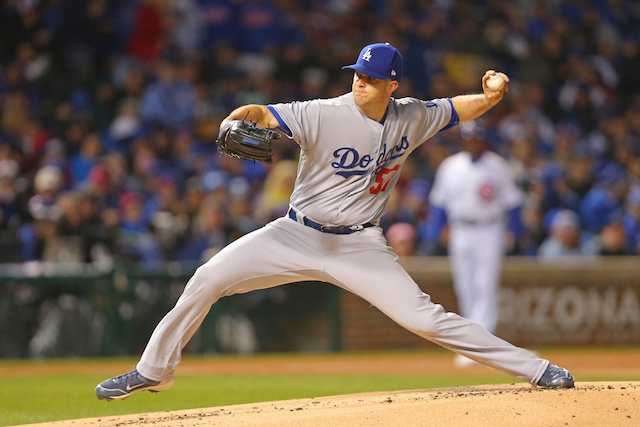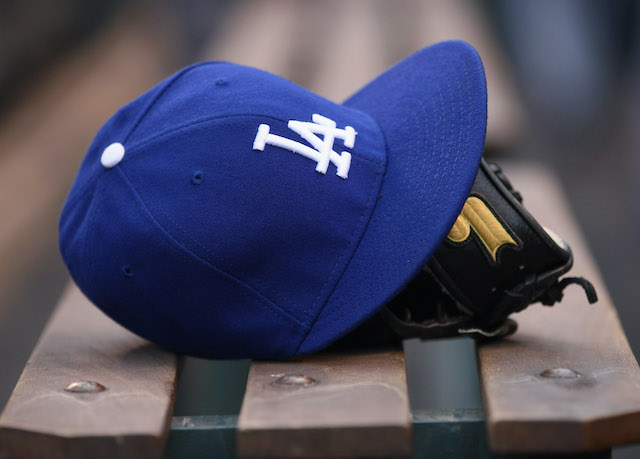While the Los Angeles Dodgers had been generally limited to acquiring young talent via the draft in recent years, 2015 saw the organization expand their horizons by making Major League trades for prospects, as well as blowing past their international spending limits.
The Dodgers’ focus on pitching is apparent in prospects ranked Nos. 26-35, while the group below features a few prospects who were added to the organization within the past year.
However, the vast majority of them will not make an impact with the Dodgers this season.
25. Brendon Davis, SS
A fifth-round selection from the 2015 draft, Davis missed most of his senior season with a broken arm. Limited looks by scouts in the spring allowed the Dodgers to get a potential steal with their 162nd overall pick.
The 18-year-old infielder is listed at 6’4 and 170 punds, though he may weigh less than that. However, that doesn’t impact Davis’ ability to swing the bat, with a smooth right-handed stroke generating plenty of line drives to the gaps.
His present power is limited but should increase with his weight. On defense, Davis may not feature the quick-twitch athleticism for the middle infield and he could lose a step as he matures, but he should fit in well at third base. Given his youth (he doesn’t turn 19 until July), a full season assignment with Low-A Great Lakes would be somewhat ambitious.
24. Starling Heredia, OF
Prior to 2015, the last Dominican amateur the Dodgers signed for more than $1 million was Joel Guzman. The club broke that streak in a big way last year, landing multiple prospects from the Dominican Republic, led by Heredia.
“Pitbull” received one of the largest bonuses of any amateur free agent during the current signing period. Listed at 6’2 and 200 pounds, Heredia is already physically maxed but has present tools and some projection remaining.
He’s an advanced hitter for his age, showing a solid approach and he’s performed in showcases against refined competition. He has some power potential and uses the opposite field.
While Heredia recorded plus times in sprints, his speed plays down because he runs on his heels. However, he’s spent time in center field and shows a strong arm, so an eventual move to right should fit his skill set. At 17 years old, he should begin his career in the Dominican Summer League, but could move to the states quickly if he hits well.
23. Chase De Jong, RHP
Yet another prospect acquired for international bonus money, De Jong came to the Dodgers from Toronto along with infielder Tim Locastro. De Jong, a second rounder in 2012, grew up in southern California and went to Woodrow Wilson High School in Long Beach.
De Jong doesn’t throw too hard, but he can locate his fastball and he gets good plane on the pitch. The curveball is his bread-and-butter, which he throws in the upper 70s and is a swing-and-miss offering. De Jong also features a slider and a changeup, though they lag behind.
At 22, he seems ready to test Double-A, although Tulsa’s rotation is likely to be overcrowded and De Jong may return to High-A Rancho Cucamonga to start the season.
22. Josh Sborz, RHP
After leading Virginia to a College World Series title and taking home Most Outstanding Player, Sborz was selected in Competitive Balance Round B in 2015. The Dodgers acquired the pick from Baltimore Orioles along with reliever Ryan Webb, who was subsequently released.
Sborz closed for the Commodores, but the Dodgers view him as a starter. His low-to-mid 90s fastball and breaking ball give him two plus pitches, but he rarely needed his changeup in college and must improve it in order to have a weapon against lefties.
If starting doesn’t work out, Sborz could make it to the Majors as a reliever. He reached High-A during his debut and should return there in 2016.
21. Omar Estevez, SS
While he didn’t receive as much as Yadier Alvarez, Yusniel Diaz or Yaisel Sierra, Estevez signed for $6 million as a 17-year-old Cuban defector. He made it over to the states for Spring Training, where he’s played shortstop.
Estevez is similar to Alex Guerrero, given his compact, mature frame and advanced bat. He has the tools to hit for both average and power in the future; other tools lag behind. Estevez isn’t a burner and doesn’t show suddenness in the field. His arm should play on the left side of the infield, but he’s likely a third baseman instead of a shortstop.
Given his youth — he turned 18 in February — he should begin 2016 in extended Spring Training and debut with a rookie ball affiliate.
CONTINUE READING: Zach Lee, Trayce Thompson and more round out top 16








